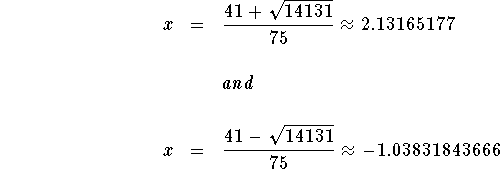


Note:
For an in-depth review on fractions, click on fractions
Solve for x in the following equation.
Problem 5.1e:

Answer: 

Solution:
Whenever the numerator or the denominator is itself a fraction, you have a compound fraction. The first step is to convert the compound fractions to simple fractions.
Multiply both sides of the equation by 15 so that the fractions are written as simple fractions.


![]()
Recall that you cannot divide by zero. Therefore, the first fraction is
valid if , ![]() and the second fraction is valid if
and the second fraction is valid if ![]() If either 2 or -1 turn out to be solutions, you must
discard them as extraneous solutions.
If either 2 or -1 turn out to be solutions, you must
discard them as extraneous solutions.
The least least common multiple (the smallest expression that all the
denominators will divide into evenly) is ![]() . Multiply both sides of the equation
. Multiply both sides of the equation  by the least common multiple
by the least common multiple
![]()
![]()
which is equivalent to
![]()
which can be rewritten as
![]()
which can be rewritten as
![]()
which can be rewritten as
![]()




The answers are ![]() and
and ![]()
Check this answer in the original equation.
Check the solution x=2.13165177 by substituting 2.13165177 in the
original equation for x. If the left side of the equation equals the right
side of the equation after the substitution, you have found the correct
answer.

Since the left side of the original equation is equal to the right side of
the original equation after we substitute the value 2.13165177 for x, then
x=2.13165177 is a solution.
Check the solution x=-1.03831843666 by substituting -1.03831843666 in
the original equation for x. If the left side of the equation equals the
right side of the equation after the substitution, you have found the
correct answer.

Since the left side of the original equation is equal to the right side of
the original equation after we substitute the value -1.03831843666 for x,
then x=-1.03831843666 is a solution.
You can also check your answer by graphing  (formed by subtracting the right
side of the original equation from the left side). Look to see where the
graph crosses the x-axis; that will be the real solution. Note that the
graph crosses the x-axis at
(formed by subtracting the right
side of the original equation from the left side). Look to see where the
graph crosses the x-axis; that will be the real solution. Note that the
graph crosses the x-axis at ![]() and
and ![]() .
This means that the real solutions are
.
This means that the real solutions are ![]() and
and ![]() .
.
If you would like to test yourself by working some problems similar to
this example, click on
Problem
If you would like to go back to the equation table of contents, click on this example, click on Contents

